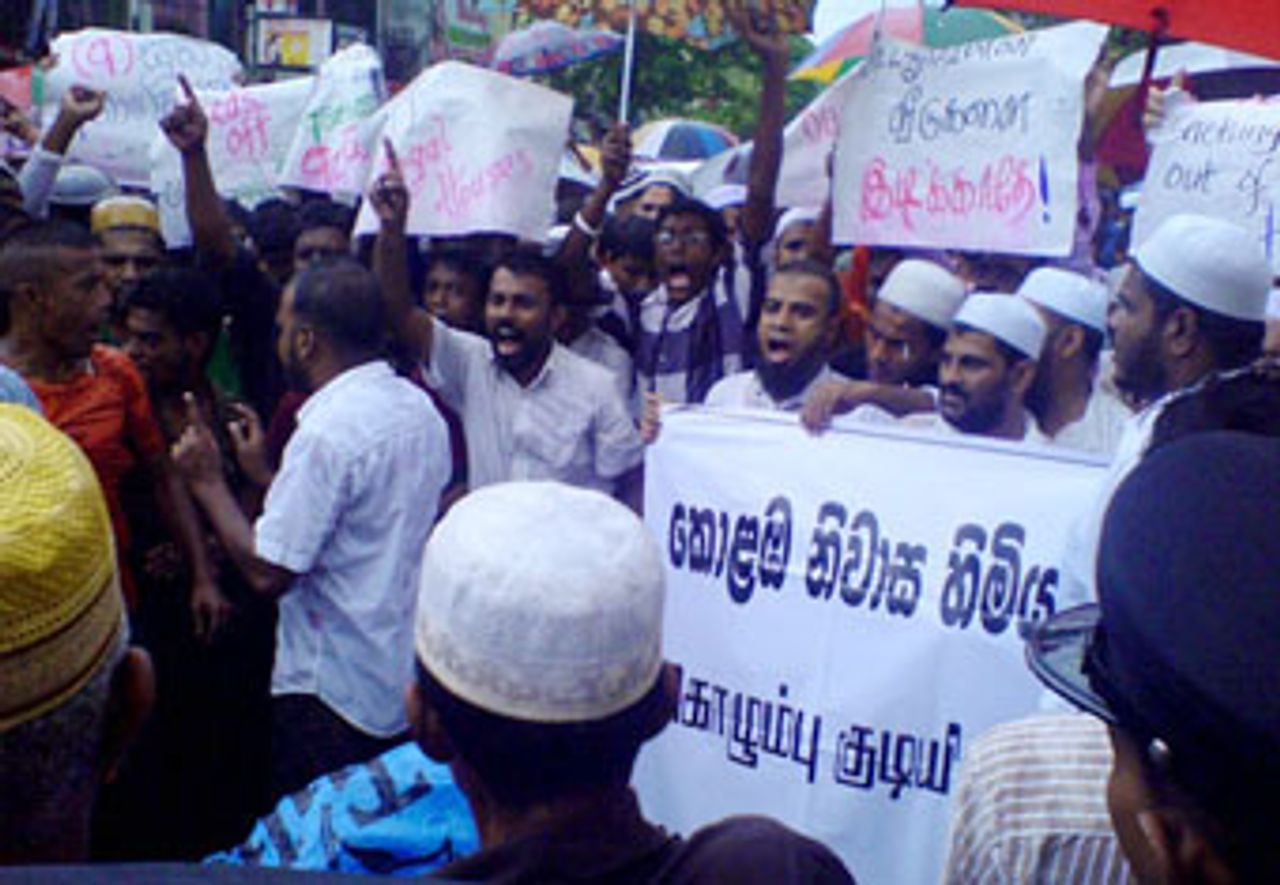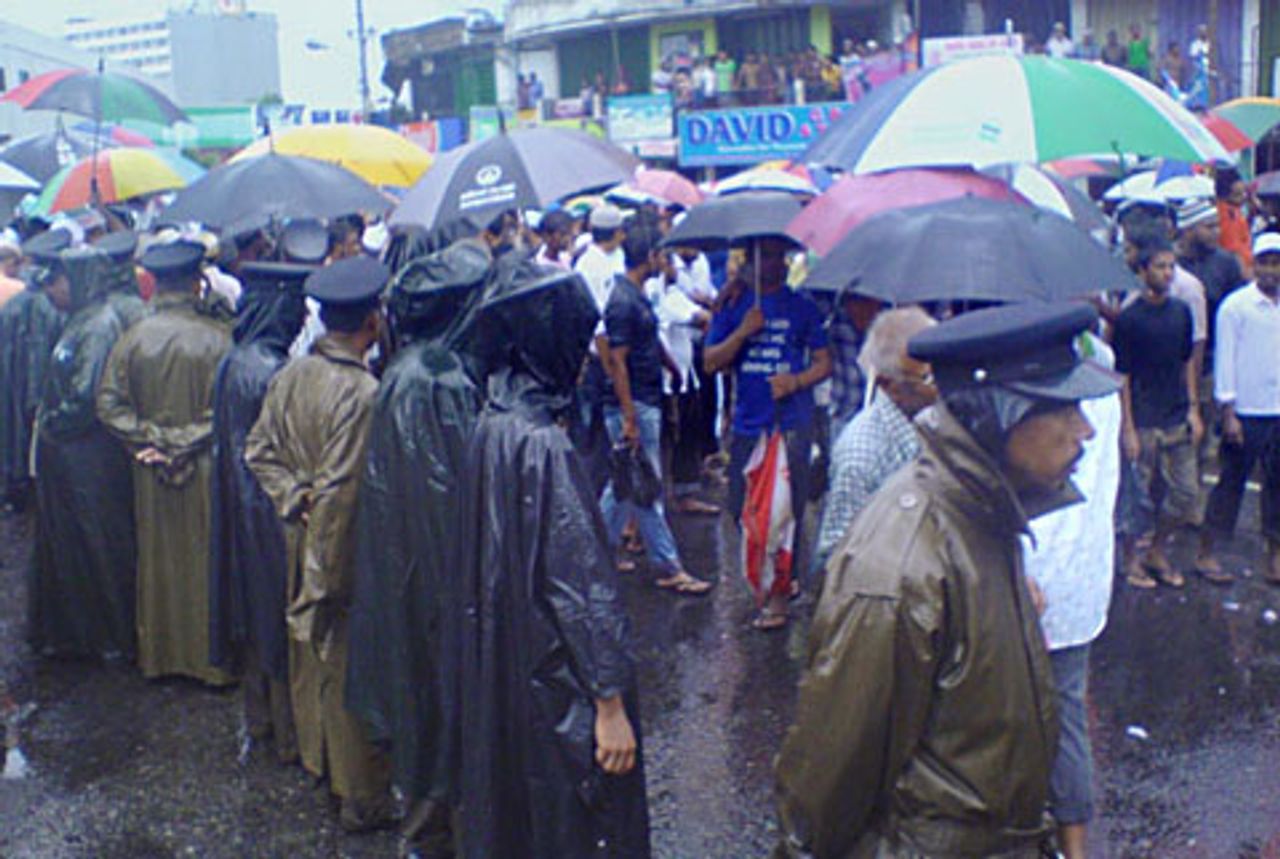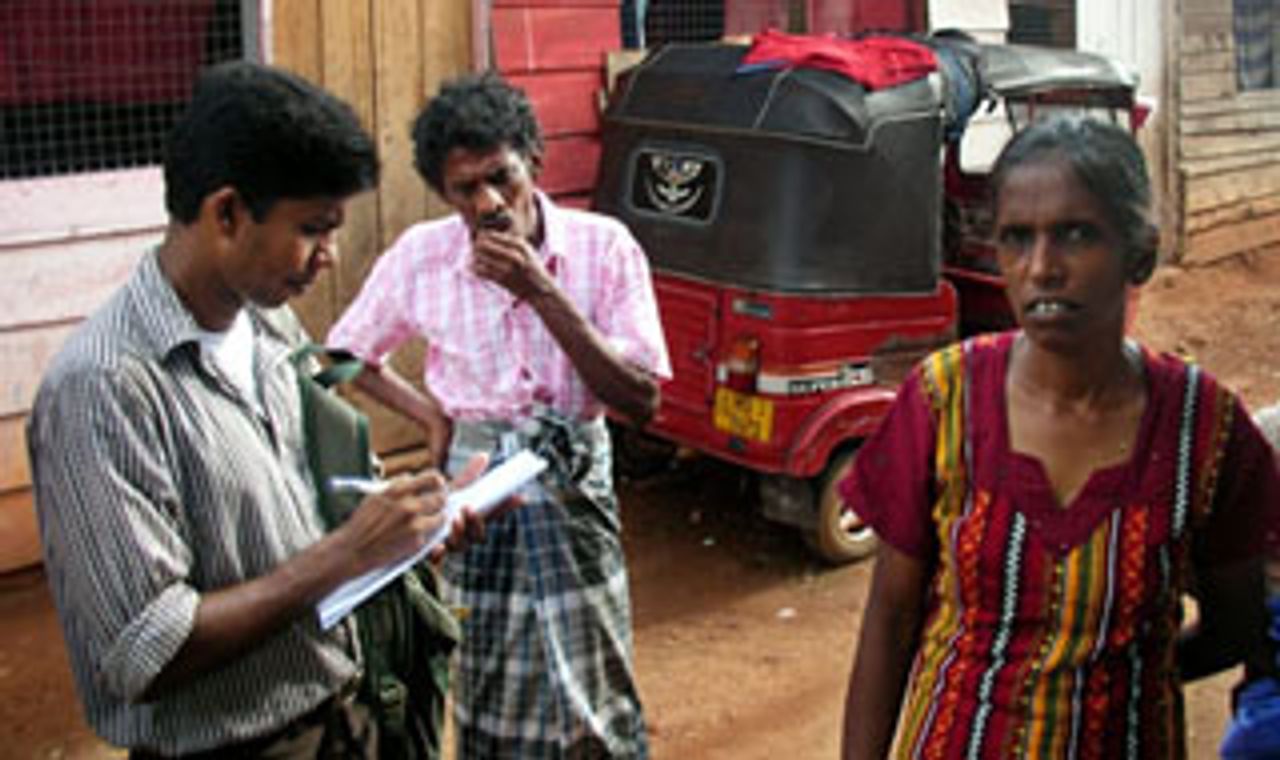About 200 people held a protest at Slave Island in central Colombo yesterday, opposing the demolition of their houses by the military. Twenty houses where 45 families—mostly Muslim—lived were bulldozed last Friday on the orders of the Defence Ministry.
 Protest against recent evictions
Protest against recent evictionsHundreds of policemen and army soldiers were mobilised last weekend to block angry residents as the homes were reduced to rubble. Riot police baton-charged and chased away the people when they resisted the government’s move.
The impoverished families have ignored the government’s order to resettle in makeshift huts at Thotalanga, a Colombo suburb. Instead, they are living in tents erected in front of their former houses. Many lost belongings, including children’s schoolbooks and clothes. They now depend on the assistance of neighbours and welfare organisations. The land where their homes once stood has been levelled, surrounded by a tin sheet fence and declared a “Prohibited Area”.
After residents refused to move, the Urban Development Authority (UDA) offered each household 100,000 rupees ($US880) as annual rental for an alternative residence. However, when men reluctantly went to the UDA office to obtain the money, they were given only 5,000 rupees to transport their belongings.
People protested yesterday in heavy rain, chanting slogans against President Mahinda Rajapakse’s government. They displayed posters with slogans such as “Hands off our houses!”, “Our children are on the street”, “Is this Rajapakse’s good governing?” and “The sensitive leader [Rajapakse] is sleeping”. Hundreds of policemen were deployed to contain the protest, and more police were mobilised in the surrounding area.
 Police blocking protesters
Police blocking protesters
Soon after his new government was installed last month, Rajapakse placed the Urban Development Authority (UDA) under the control of the Defence Ministry. Defence Secretary Gotabhaya Rajapakse, one of the president’s brothers, declared the Slave Island shanties to be “eyesores” that had to be removed. The government is seeking to clear what is prime real estate for development.
Yesterday’s protest was called by the “Foundation for the protection of houses of Colombo residents”. The group has been organised by the opposition United National Party (UNP), the Sri Lanka Muslim Congress (SLMC), the Janatha Vimukthi Peramuna (JVP) and the Nava Sama Samaja Party (NSSP).
SLMC leader Rauf Hakeem declared the group would take legal action, saying: “It is disgraceful the way people have been evicted. They should have at least been given one month instead of two hours.” UNP provincial councillor Mujibur Rahman claimed that the eviction was retaliation for many shanty dwellers voting UNP in last month’s parliamentary elections.
Chamal Jayaneththi, a NSSP leader, was even more demagogic, declaring: “This is not Mahinda’s vision but Mahinda’s dastardly vision. We say that we are firing the first shot to expel the Mahinda’s vision at Slave Island. We can’t allow the building of this country in this method. This is a disastrous development.”
Despite all of the rhetoric, none of the speakers demanded that those evicted have proper houses rebuilt on the sites where their homes were demolished. They tacitly accept the eviction as a fait accompli and the government’s “right” to oust the shanty dwellers from “illegally occupied” land. If it is initiated, their legal case is likely to be for a bit more compensation to placate angry residents.
Again the most insidious role is being played by the ex-radicals of the NSSP who have joined hands with the right-wing UNP and Sinhala extremist JVP in blocking any independent political struggle for decent, low cost housing against the Rajapakse government. When in power, the UNP evicted residents from areas of Colombo and has a long record of attacking basic democratic rights.
The eviction of the Slave Island residents is part of a government’s broader plan to oust large numbers of slum dwellers and free up 1,000 acres of lucrative real estate in central Colombo for development by investors. The UDA has also launched a related operation to crack down on thousands of street hawkers.
These operations, directed against the poorest and most vulnerable members of society, are a warning of the methods that the government will use against the entire working class as it implements the austerity measures required by the International Monetary Fund.
Workers should come to the defence of those evicted from the Slave Island shanties. While they have no formal legal right to the land, many have lived in the area for decades, in some cases generations. They confront the same problems as working people throughout the island, including the lack of proper accommodation and essential services such as electricity, clean water and sanitation.
Just as the government is demolishing these shanties to make way for property profiteers, so it is preparing to make deep inroads into public spending and essential services to meet the demands of global financial markets. The only way of defending the rights of the evicted families is through a political struggle against the Rajapakse government based on a socialist program to meet the needs of the majority, not the private profits of the wealthy few.
The starting point of such a fight is the establishment of action committees in the shanties and working class areas independent of all of the capitalist parties, including the UNP, the JVP and ex-lefts, that keep the working class tied to the bankrupt profit system. That is the program advocated by the Socialist Equality Party.
WSWS reporters spoke to residents at Slave Island, including some who had been evicted. A married woman explained: “We cannot live in the houses offered by the UDA at Thotalanga. Actually you can’t describe them as houses. They are just wooden boxes put up in muddy land. There is no proper ventilation. The drains are overflowing. The bad smell is unbearable. Since we lived in houses that were a hundred times better than those, why should we go there? We all decided not to go.”
Another housewife said: “A hundred thousand rupees is not enough for half a year’s rent for a house, even in a suburb. At the same time we don’t know how long we will have to live in a rented house. We don’t have any trust that they will build houses for us.”
A young mother described the brutality of the eviction operation. Police hit her daughter when she tried to get her schoolbooks out. “They gave us only one hour to evacuate,” she said. “After that they began to attack our people in an inhuman manner. They didn’t even care about the elderly and the children. Now we can imagine how they treated the people in the North during the war.”
 WSWS interviews people evicted in 2008
WSWS interviews people evicted in 2008In 2008, when people from Glenn Passage in Slave Island were evicted, the government claimed that the decision was necessary for the security of the residents. A resident recalled what the government had said. “They told us there could be an LTTE [Liberation Tigers of Tamil Eelam] attack on the air force that would affect neighbouring civilians. What sympathy toward us! Now the war is over, and the LTTE is no more. It is not the LTTE, but the army and the police that attacked us brutally.”
A WSWS team visited the “transitional residences” provided to former Slave Island residents at Thotalanga. The condition of the huts and their surrounds are even worse than described by the evicted residents. The 73 families removed from Glenn Passage are still languishing in a marsh-like area. They have not received houses, as the government now claims they were illegal residents. A housewife commented: “Many government politicians promised us to provide new houses for us. But after almost two years we still live in this hell.”
The author also recommends:
Sri Lankan defence ministry begins evicting poor in Colombo
[10 May 2010]
Sri Lankan military takes over urban development
[13 May 2010]
